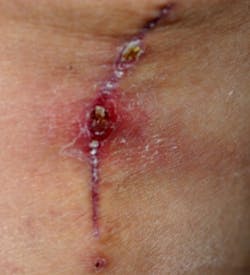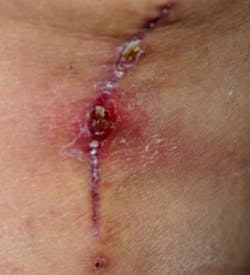Sun exposure or tanning beds?
Your patient today is 15-year-old Jennifer. As you seat her in the operatory, you begin to assess her general well-being and physical features. It is January 2012, and Jennifer appears very tanned for the season, yet it is obvious that she is also very fair-skinned with blue eyes.
She comments on a wonderful holiday season spent with family and friends. You reply that it appears as if she went to a tropical area for her vacation. It turns out that she was given a gift of tanning bed certificates by a friend over the holidays, and she has been to the tanning bed facility several times during the past week. She plans to go again next week.
You quickly assess your knowledge of tanning beds, trying to remember what you have learned about them in recent years. Your first question is, “Was this a spray-on tan, or did you actually lie in a tanning bed?” She tells you that she did not have a spray-on tan. What do you know about tanning beds that you can share with this patient that may assist her in long-term total health?
Adolescents and young adults are especially susceptible to the damaging rays of ultraviolet light, since their cells are dividing and changing more rapidly than those of adults. In a 2006 campaign directed toward teenage girls, the American Academy of Dermatology issued a public service announcement aimed at girls in the 12- to 14-year-old age group. This target population was selected because most have not started using tanning beds at this stage of life.
Tanning beds emit UVA (longer wavelengths that penetrate deeply into the tissues) and UVB (shorter wavelengths causing sunburns) radiation at levels that can be much stronger than the sun. Annually, according to the American Academy of Dermatology, more than 28 million people tan in tanning salons in the United States. Women and girls aged 16 to 29 years make up 70% of the total number of individuals using tanning beds.
As we know, ultraviolet light is a known risk factor for melanoma and basal cell and squamous cell carcinoma. There has been a 75% increased risk in melanoma for those who use tanning beds. And, this number includes those who may use these facilities only a few times.
Currently, only 36 states regulate or restrict youth access to tanning bed facilities. However, many do not allow minors under a certain age, such as 14 years old. In October 2011, California became the first in the nation to prohibit the use of indoor tanning devices for all children and adolescents under the age of 18. Other states are expected to follow in the banning of tanning salons for children.
California is expected to have 8,250 new cases of melanoma in 2011, placing them at 12% of the total national cases of melanoma. The rates have steadily increased for the past 30 years. It is estimated that 123,590 new cases of melanoma will be diagnosed in the United States in 2011 and 8,790 are expected to die from deadly melanoma.
Problems related to tanning beds have been compounded by the fact that the genitalia and the eyes are often not protected and are highly susceptible to the damaging radiation that is incurred during exposure. The genitalia are especially vulnerable and are rarely exposed to intense ultraviolet rays unless the individual is using a tanning bed. Melanomas are known to occur on the back of the legs and the thighs. These areas are often exposed during sunbathing by teens, especially. It is known that some individuals remove any protective glasses once in the tanning beds because they do not want the whiter skin area around the eyes that occurs with protective glasses.
The bulbs in tanning beds must be monitored and replaced frequently to keep the emitted UV levels at determined standards. Some facilities have been found to fall short of this requirement, thereby causing even more exposure to the customer.
The advertisements for tanning salons often purport that tanning beds are “safe” and that they do not cause skin damage. The false advertising of tanning facilities has elicited a strong reaction from the American Academy of Dermatology. The academy supports restriction of the use of words such as “safe tanning,” “no harmful rays,” “no adverse effect,” etc. The academy is committed to providing the correct information to those who use tanning salons and discourage this risky behavior.
As always, keep asking good questions and always listen to your patients.
References
http://www.aad.org/media-resources/public-service-advertisements/view-psa/view-psas.
Facts and Figures-Includes a Mole Map. http://www.aad.org/media-resources/stats-and-facts/conditions/melanoma/melanoma.
American Cancer Society. 2011 Cancer Facts and Figures. http://www.cancer.org/Research/CancerFactsFigures/CancerFactsFigures/cancer-facts-figures-2011.
http://knowledgecenter.csg.org/drupal/system/files/FF__Tanning_Bed.pdf
http://www.aad.org/media-resources/stats-and-facts/prevention-and-care/indoor-tanning
UVA/UVB skin protection: Advising patients
The following guidelines are provided to reduce the risk for skin cancer through skin protection. As healthcare providers, we are obligated to share all health related information to our patients as a part of total health. These suggestions were modified from the textbook General and Oral Pathology for the Dental Hygienist, which contains the entire clinical protocol.
- Sun avoidance is the best defense. Remember that sunscreens reduce the damaging effects, but do not eliminate them.
- Use a broad-spectrum protection sunscreen of at least an SPF #30 (Sun Protection Factor) and apply approximately one ounce 20 to 30 minutes before going out into the sun. A measurement device equivalent is a shot glass or a “golf ball size” portion. Apply every few hours, and always reapply after going in water. When going in the water, use a waterproof sunscreen and reapply after 50 minutes if you have been in the water for that amount of time. Reapply if you perspire a lot. Do not assume that a higher SPF will protect you much longer than a lower one (i.e., SPF 30 vs. SPF 50). There is only a slight variation in the protection abilities.
- Active ingredients of a sunscreen should contain titanium dioxide or zinc oxide. Both protect against both UVB and UVA exposure.
- Seek shade between 10 a.m. and 4 p.m. This is the time when the ultraviolet light is the most intense. Even cloud cover allows 80% of UV rays to pass through.
- Wear a wide-brimmed, tightly woven hat that has been specially treated to block the sun’s rays. Wear opaque clothing specially treated to protect the skin (one that has a UPF [ultraviolet protection factor] of 30 or more).
- Use a lip balm containing PABA (para-aminobenzoic acid) as an active ingredient and at least an SPF of 15. Some lipsticks now contain the sunscreen as well. Read the labels.
- Wear sunglasses with wraparound frames that have total UV-blocking capacity. Avoid metal frames. Metal frames intensify the damage from the sun. The eye area is a prime location for basal cell carcinoma due to the sun’s damage on the skin.
- Perform skin self-exams monthly using a hand mirror, and search for any skin spots that have changed color, size, or shape.
- Be evaluated by your dermatologist at least once a year or every six months if you have a history of skin cancer, especially melanoma. Always make an appointment for any new noticeable growths or changes in your skin.
Nancy W. Burkhart, BSDH, EdD, is an adjunct associate professor in the department of periodontics, Baylor College of Dentistry and the Texas A& M Health Science Center, Dallas. Dr. Burkhart is founder and cohost of the International Oral Lichen Planus Support Group (http://bcdwp.web.tamhsc.edu/ iolpdallas/) and coauthor of General and Oral Pathology for the Dental Hygienist. She was a 2006 Crest/ADHA award winner. Her website for seminars is www.nancywburkhart.com.
Past RDH Issues

